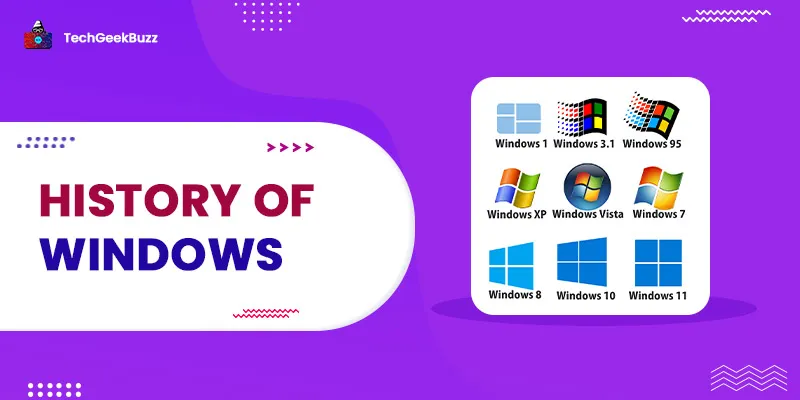With over 1.5 billion active users, Windows is the most popular operating system. Since its introduction in 1985, it’s been one of the cornerstones of the computing and IT revolution that has transformed our society. The polychromatic parallelograms in the Windows logo have become a universally recognized symbol of technological innovation.
Over the years, Microsoft has released nine major versions of the Windows operating system, each with its own distinctive features and functionalities. Today, Windows 11 seems almost unrecognizable when compared to 1985’s Windows 1.
In this blog post. we will take a walk down memory lane and look back at the iconic past of the Microsoft Windows operating system.
History of Windows Operating System
1. Windows 1.0
Released on November 20, 1985, it was the first major release of Microsoft Windows. Microsoft’s founder Bill Gates was inspired to develop Windows 1.0 after seeing a similar software suite named Visi On at a computing exhibition in 1982.
Windows 1.0 ran on MS-DOS in the form of a 16-bit shell program called MS-DOS Executive. It could run graphical programs designed specifically for Windows alongside existing MS-DOS software. Also, it introduced multitasking and the extensive use of the mouse and incorporated features, like calculator, Paint, and Notepad.
Windows 1.0 had 4 releases, and it was supported by Microsoft till December 31, 2001, making it the longest supported version.
2. Windows 3.1
Windows 3.1 was released on April 6, 1992, and it was the first Windows version that comes equipped with TrueType fonts, making it the first viable publishing platform. Still based on MS-DOS, it introduced several improvements, such as better system stability, increased multimedia support, and workgroup networking.
On Windows 3.1, the iconic game Minesweeper was seen for the first time. Its registry, a centralized database that stored configuration information and settings for various operating system components and applications, was also introduced. Windows 3.1 was the first operating system to be distributed on CD-ROMS.
There were 4 release versions of Windows 3.1, and Microsoft provided support and updates for it till December 31, 2001.
3. Windows 95
As the name suggests, Windows 95 was released to the general public in August 1995. The first operating system in Windows’ 9x family merged MS-DOS and Microsoft Windows.
This operating had a much improved graphical user interface (GUI) than its predecessors and pioneered the concept of “plug and play” – if you connected a peripheral device to the system, the system would find the appropriate drivers without requiring any manual intervention. This greatly improved the user experience.
Windows 95 had the first-ever Start button and Start menu. In addition, it introduced a 32-bit operating system instead of the 16-bit on the earlier versions, the taskbar, and the notification area. Computer accessibility features like Sticky keys, FilterKeys, ToggleKeys, and Mouse keys were also seen for the first time in this version.
Like its predecessors, Microsoft halted support for Windows 95 on December 31, 2000.
4. Windows XP
It was released for retail by Microsoft on October 25, 2001. Although the design of Windows XP looks similar to the Windows NT, it was the first edition that was not based on Windows 95 kernel or MS-DOS: it was a GUI operating system.
It included many of the consumer-friendly elements seen prior in Windows ME. The green Start button, blue taskbar, and Vista wallpaper were introduced in the Windows XP. Also, it introduced ClearType, which made it easier to read text on LCD screens, CD burning, auto-play of CDs and other media, and automatic updates and recovery tools.
XP had excellent networking and internet functionality: Internet Connection Firewall, NAT traversal APIs, network bridging, peer-to-peer networking, etc., were added to this operating system.
Windows XP was acclaimed for its performance and stability, user-friendly interface, enhanced hardware support, and expanded multimedia functionality. Microsoft terminated mainstream support for XP on April 8, 2014, 13 years after its release. At the end of its official support, it was still used on approximately 430 million computers – a testament to its staggering popularity.
5. Windows Vista 2006
Windows Vista was made available to the general public on January 30, 2007; five years after the release of the XP. At that time, this was the longest gap between the release of two operating systems by the company.
New features introduced in Vista include an updated GUI termed Aero, a brand-new search component dubbed Windows Search, new networking, audio, display, and print systems, and multimedia tools like DVD maker. Moreover, the OS used peer-to-peer technology to make it easier to share files and media between different computers and devices.
It also supported the .NET framework 3.0, which allows software developers to create applications without using conventional Windows APIs.
Like its predecessors, Vista was a smashing success in the general market. By 2009, there were an estimated 330 million users. Microsoft ceased mainstream support for Vista on April 10, 2012.
6. Windows 7
Microsoft released Windows 7 on October 22, 2009, around three years after the release of Windows Vista. It Intended to fix all the flaws and criticisms faced by Vista. Also, Windows 7 proved to be faster, more stable, and easier to use compared to its predecessors.
It continued the work on the Aero visual style introduced in Vista; a redesigned taskbar made it possible to pin applications. Also, new window management features (such as maximizing a window when it was dragged to the left, right, or top of the screen) were introduced.
Windows 7 focused on improving handwriting recognition and touch features. It also supported virtual hard disks and introduced new options, including Gadgets, Recovery, Troubleshooting, and Display, to the Control Panel.
By July 2012, Microsoft had sold over 630 million licenses for this version. Mainstream support for Windows 7 ceased on January 13, 2015.
7. Windows 8
Released on October 26, 2012, Windows 8 introduced major changes to the user interface and aimed at improving the user experience on touch-based devices, like tablets.
The Start button and Start menu were replaced with a touch-friendly Start screen. Windows Store, which could be used to buy and download new software, and a new keyboard shortcut for screenshots were added. It included support for USB 3.0 and cloud computing, built-in antivirus software, and support for ARM architecture (the first operating system to do so).
By January 2013, more than 60 million of its licenses had been sold. In October 2013, Microsoft released Windows 8.1, to address some of the critical issues in Windows 8.
8. Windows 10
Made publicly available on July 29, 2015, Windows 10 introduced a more desktop-friendly interface that replaced the Start screen with a Start menu. Also, it introduced Xbox Live, Cortana personal assistant, and Microsoft Edge (the replacement for Internet Explorer).
Windows 10 is the final version of Windows that supports 32-bit processors and BIOS firmware.
By January 2018, Windows 10 surpassed Windows 7 to become the most popular version of the Windows operating system worldwide; by 2020, more than one billion Windows 10 licenses had been sold.
Conclusion
The popularity of Microsoft Windows cannot be overstated; you’re probably reading this article on a Windows machine. The ease of use, powerful features, and low cost have made Windows OS a fan favorite for decades. Also, with the release of Windows 11, it seems like the popularity of Windows OS is not going to fade any time soon.
We hope you enjoyed this article by learning more about the history of the most iconic operating system in the world.
People are also reading:




